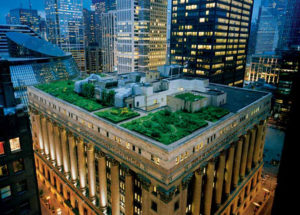
Green roofs have become a popular amenity in cities as city dwellers seek environmentally friendly places to work, live and breathe.
Rachel Eckenreiter, Animal Science
Justin Esiason, Environmental Science
Patrick Meehan, Building Construction Technology
As the sun rises in Beijing, the workforce can be seen flowing into the arteries of the city to start the day. The streets steadily fill with people, some whizzing by on bicycles, others on foot as the sun fights through toxic haze and dust. A father and daughter navigate through the dense crowd, completely unfamiliar with the language spoken around them and written on street signs, the young girl quickly glances around her, confused and overwhelmed. Faces of many sizes, ages and shapes glide by, most clad in white medical masks. Her eye catches something they’ve seen before: the welcoming sign of their hotel. The bright and quiet lobby is cool and clean as they head toward the elevator. Once in the room, she wastes no time and heads straight for the bathroom sink, with the sensation that her face is covered in grime as if she had worked in a dry dirt field all day. After washing her face, she glances down to find that the pristine white hand towel had turned mostly dark grey and brown. Although their stay in China was only three weeks long, it was enough time to recognize that the city of Beijing had a major air pollution problem. (Rachel Eckenreiter, Personal Communication, April 6, 2017). Continue Reading











Recent Comments